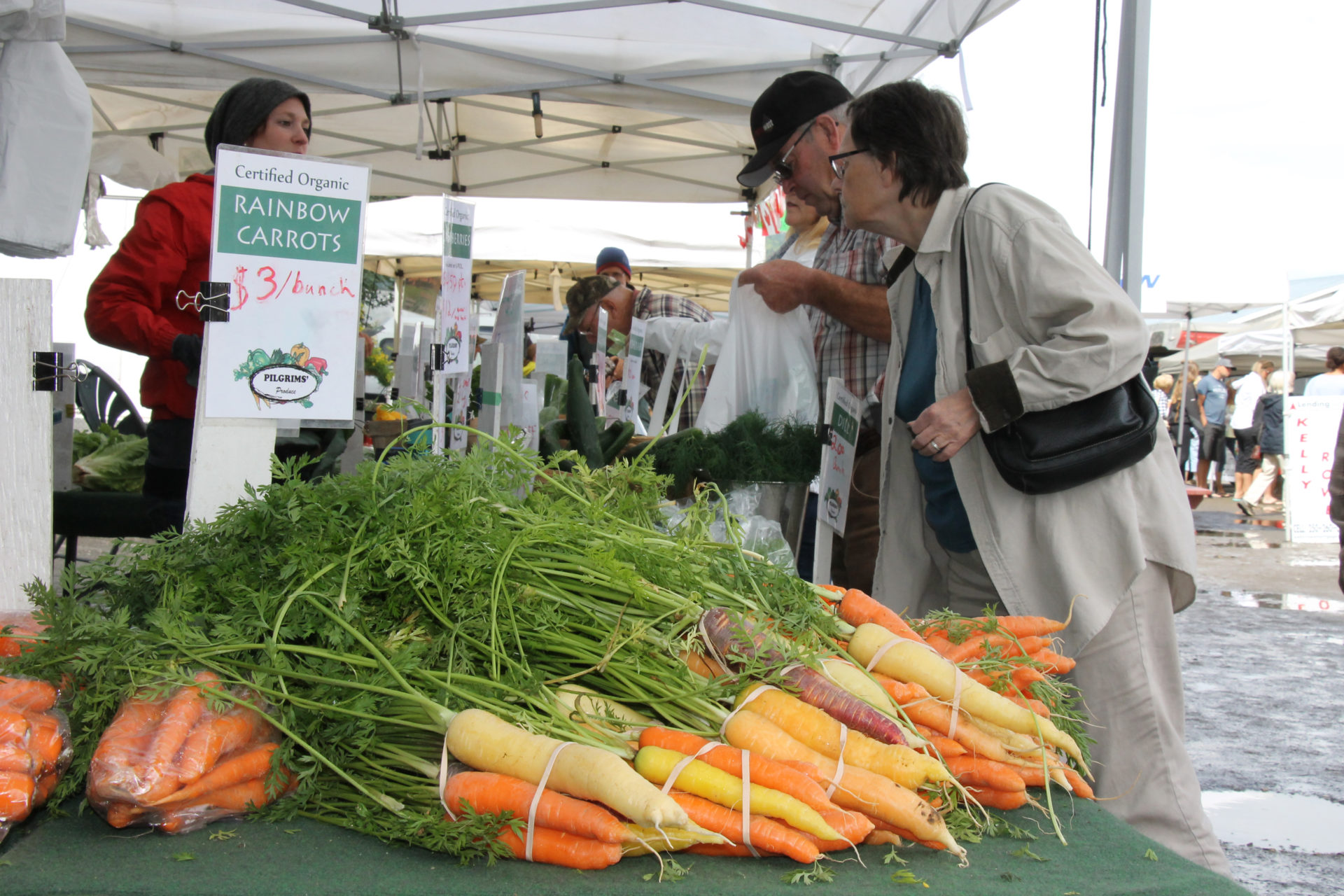VICTORIA – Renewed efforts to promote BC farmers’ markets are in the works following a study that identified a need for common branding and a greater awareness among consumers of the value farmers’ markets offer.
“This year, we’ve secured dollars to launch this BC Farmers’ Market Trail,” Heather O’Hara, executive director of the BC Association of Farmers’ Markets, told the association’s annual conference in Victoria at the beginning of March.
The trail will start in the Kootenays, where the BCAFM has secured a funding partner (O’Hara would not disclose the partner pending an official announcement). The project will be similar to the BC Ale Trail that the BC Craft Brewers Guild and local tourism associations established.
“It’s going to be heavy on digital engagement. We’re going to have the ability to have videos and tell the story of your market and the farmers within it very strongly and beautifully,” O’Hara said.
The launch of the program will accompany efforts to secure funding to expand the initiative to regions across the province by 2020. It will contribute to a common brand identity for farmers’ markets across BC.
BCAFM is also putting up cash generated from the investment of funds the province granted for the farmers’ market nutrition coupon program. The coupon program also gave association staff the opportunity to travel the province, building the relationships that make the new marketing initiative possible. The new campaign builds on research Nanaimo-based Left Field Marketing and its Farm| Food|Drink business advisory team conducted last year.
Presenting the results of the research during the conference’s opening plenary, research lead Vanessa Daether said the project aimed to understand how markets promote themselves and what motivates consumers to shop where they shop.
“We really wanted to understand how farmers markets in the province of BC are marketing their markets and engaging with their customers,” she said.
Daether conducted an overview of online marketing tools – Facebook was key – and strategies markets use to promote themselves to both vendors and consumers. Sixty markets attended focus groups and provided feedback, and this was combined with feedback from a survey of 1,000 consumers.
The study also examined what grocers are doing to adapt to a changing retail environment and how farmers’ markets can keep pace. (Notably, there’s no firm research on what share of the market BC farmers’ markets have.)
“Where can we shift consumers from grocery store dollars to spending more at a farmers market?” researchers asked. “Who are those individuals we can capture?”
The project identified three types of shoppers:
- Frequent shoppers are typically women, 35 years and older with above-average incomes who are engaged with their communities and socially conscious. They spend $76 to $200 a week at grocery stores, but visit farmers’ markets about twice a month and spend $20 to $40 per visit.
- Infrequent shoppers are similar to frequent shoppers but often have young families that limit visits to a few times a season. When they do visit, they spend $40 or less.
“Prices and time were the big barriers that were limiting them from engaging with a farmers market,” Daether said. “It wasn’t a lack of desire or interest or necessarily knowledge about a farmers market. They’re just busy. They’re swamped individuals.”
- Non-shoppers are typically people in their 20s with below-average incomes. Most grocery shopping is at supermarkets rather than organic grocers or health food stores.
“For this demographic, price sensitivity is heightened,” Daether said.
While convenience and price are key barriers to drawing in younger shoppers, Greg McLaren, managing director of Left Field, said it’s not because they’re not interested.
“They’re part of the choir already and we need to bring them along and grow that market. And believe me, the grocery sector is worried about that,” he said.
Connecting with them requires being more convenient, or giving them a reason to see it as a valuable shopping choice.
“[It]’s not suggesting to folks that it’s cheap or that we can compete on price – price is different than value – [it’s] talking to people about how you do community,” McLaren said. “You tie into their values.”
But translating those values into a sustainable future for markets and vendors is another question.
“The local food movement has changed drastically,” he said. “We’re seeing small farmers – young, smart, engaged, hard-working people with wonderful values – have been making a good push on things for two, three, five years, and are now exiting, because poverty gets old fast. It’s tough.”
McLaren said farmers’ markets, to be viable, need to both attract shoppers and support vendors.
“There should be a lot of focus among the farmers’ markets on viability,” he said. “You need to have that support for the farmers, and offering them the support through the BC Association of Farmers Markets and your markets themselves to recognize that you are not just a shopping centre, not just a place of community, but a place where you’re driving the economy of agriculture in the province.”
Put the cannabis story below on the same page as the story above
Cannabis smoke screen
Farmers’ markets don’t know where they stand
by PETER MITHAM
VICTORIA – A new season is around the corner for the nearly 150 farmers’ markets in the province, but the potential legalization of recreational cannabis this summer has many wondering how to handle the controversial new crop.
Recreational cannabis could have standing as a legitimate crop as early as July 1, though expectations of delays are rising as governments scramble to prepare. Still, market managers attending the annual conference of the BC Association of Farmers’ Markets in Victoria at the beginning of March pleaded for guidance on how to deal with potential vendors of a product not everyone considers acceptable.
Unfortunately, there wasn’t much to give.
“The federal and provincial governments hadn’t established any information to give to us,” BCAFM president Wylie Bystedt told market managers at the association’s annual general meeting.
While producers require federal licences, the provinces are setting the ground rules for retail sales. BC has handed jurisdiction over cannabis to the ministry of the attorney general, which oversees liquor sales. While retail sales will be through the BC Liquor Distribution Branch, licensing of cannabis-related activities will fall to the BC Liquor Control and Licensing Branch, which is launching an online licensing portal to manage applications.
Where those licences are exercised will be up to local government, which is responsible for zoning and business licensing.
This is where farmers’ markets will need to look for guidance, Bystedt said, as markets must respect local bylaws.
While a number of licensed and illegal dispensaries operate in Vancouver, some just steps from current farmers’ market locations, not all municipalities are so liberal.
Delta and Richmond, both of which are home to production facilities eyeing the recreational market, are among the municipalities that have passed bylaws forbidding cannabis dispensaries.
Residents of Central Saanich recently delivered a 1,400-signature petition to BC agriculture minister Lana Popham objecting to cannabis production on a local dairy farm. Protected agricultural land should be for food production, a view many at the farmers’ market conference also voiced.
However, James Mack, an assistant deputy minister with the agriculture ministry, told farm organizations in February that cannabis is a crop and therefore can’t be banned from farmland.
Or, as John Bell, a veteran member and past president of the BCAFM remarked: “It’s really not the Ministry of Agriculture that’s going to be dealing with it; it’s the [attorney general].”
While local health authorities will have requirements for cannabis products, staff from the BC Centre for Disease Control told BCAFM members that they have developed nothing to date because cannabis isn’t yet legal. Cannabis edibles, which BCAFM expects to be the key product for market vendors, won’t be legal until 2019.
However, because they stand to be the most accessible products and most appealing to unwitting children, concerns exist about how best to balance marketing for adults with youth safety.
To help markets navigate the challenges and speak with a unified voice on the issue, BCAFM staff pledged to develop guidelines and a template for working with potential cannabis vendors by early August.


 ALR sessions closed to public
ALR sessions closed to public